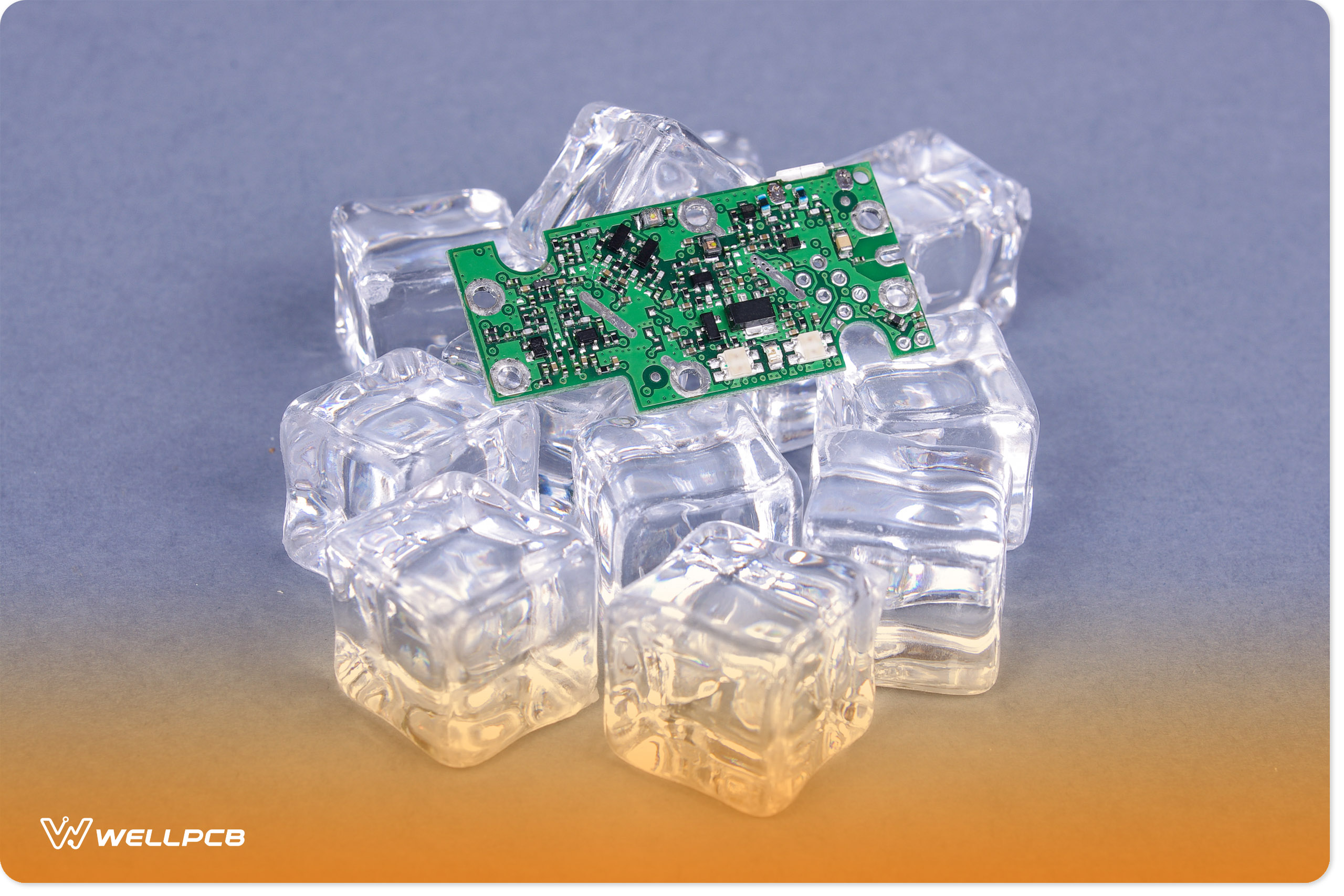Contents
PCB Material Understanding
PCB constructions are often divided into three main layers:
- Circuit Layer: This is a copper layer with a thickness typically ranging from 1 to 10 oz, responsible for conducting electrical signals.
- Insulating Layer: This dielectric layer is made of thermally conductive yet electrically insulating material, providing essential separation between the circuit and base layers.
- Base Layer: Often composed of materials like copper or, in many cases, aluminum PCB substrates. Aluminum substrates are especially popular for their effective heat dissipation and durability. Multiple thickness options are available for the base layer, with 1mm being the most common choice.
When selecting a base layer material, factors like heat management and structural support are crucial, and aluminum PCB substrates offer an excellent balance of these qualities, particularly in high-power applications.
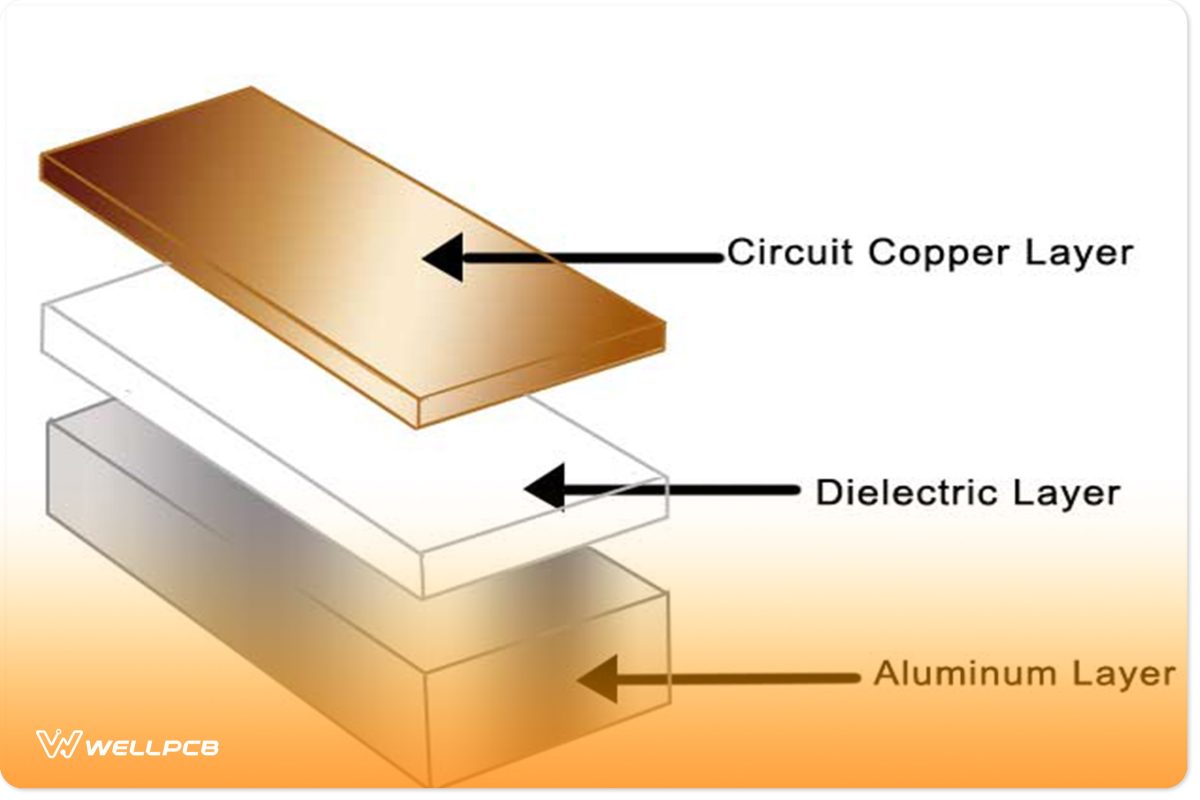
Insulating Layer
A dielectric material is a substance that is a poor conductor of electricity and is used as an insulating layer in the PCB build-up. Porcelain, mica, glass, plastics, and some metal oxides are good dielectrics.
The lower the dielectric loss (the proportion of energy lost as heat), the more effective the dielectric material.
If the voltage across a dielectric material becomes too high — that is, if the electrostatic field becomes too intense — the PCB material will suddenly begin to conduct current. This phenomenon is called dielectric breakdown.
PCB Substrate Material
PCB has two layers of material. One is the upper layer, and the other one is the lower layer. As we know the top layer is vital for the reactions and other purposes, and all of the PCB designing is dependent on that film.
Likewise, the lower layer is also significant for designing purposes. If you estimate the worldwide substrate market, it is approximately equal to 51 million square.
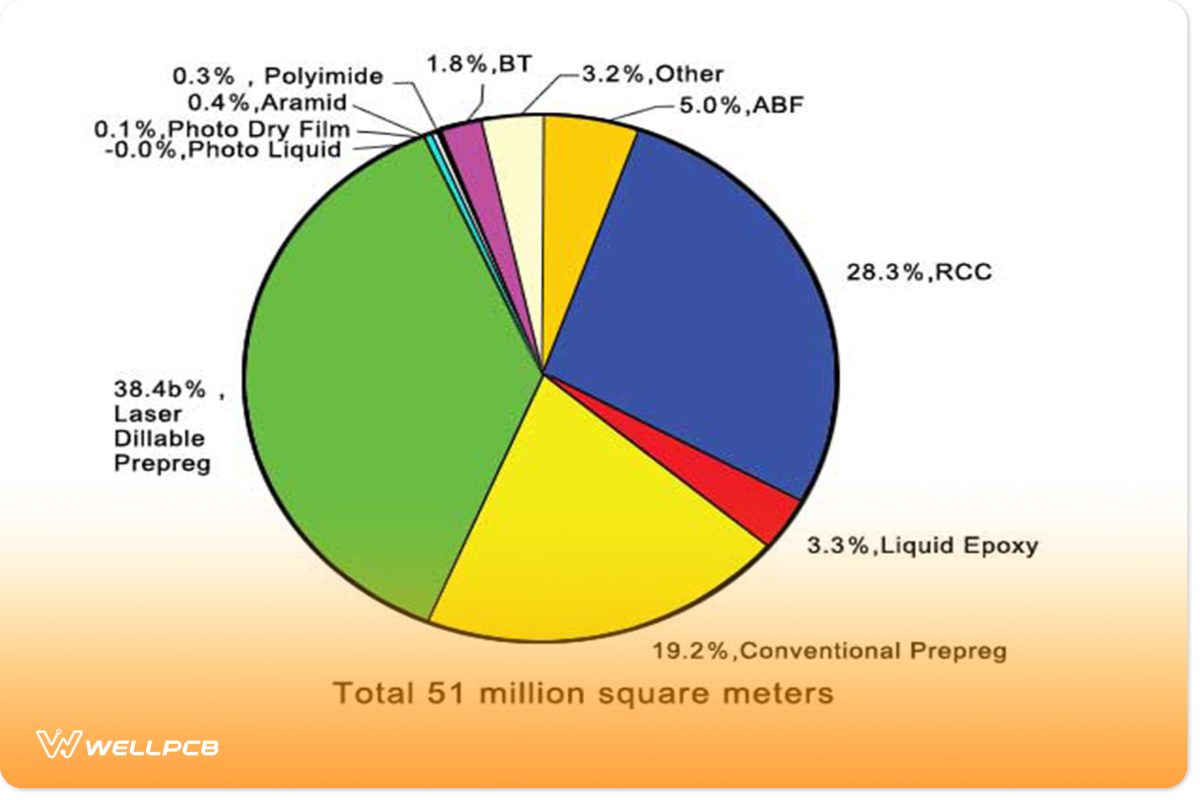
The majority of the substrate materials will mix with epoxy, and some of them will combine with BT mixture. The majority of the market uses the alternate layers of the dielectric PCB material, with or without reinforcement stacked at the metal foil to form the PCB.
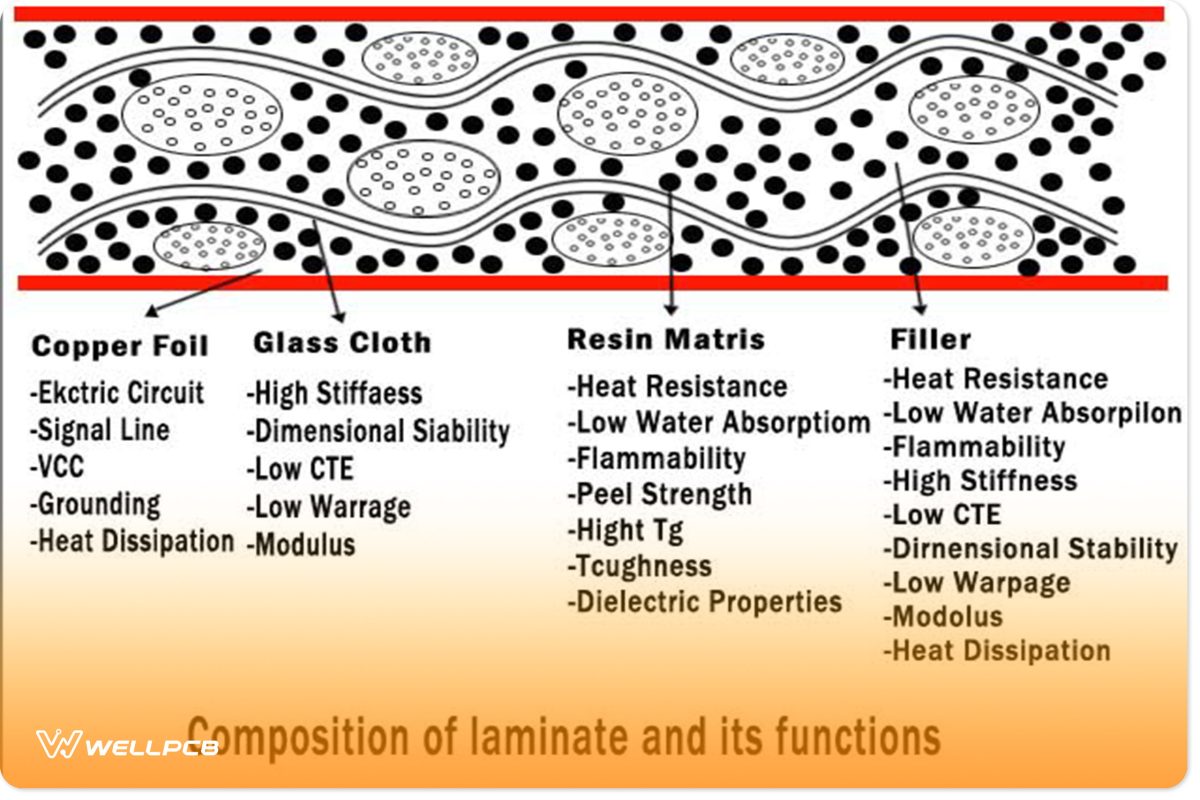
The below chart will give you the best idea for the selection of the substrate:
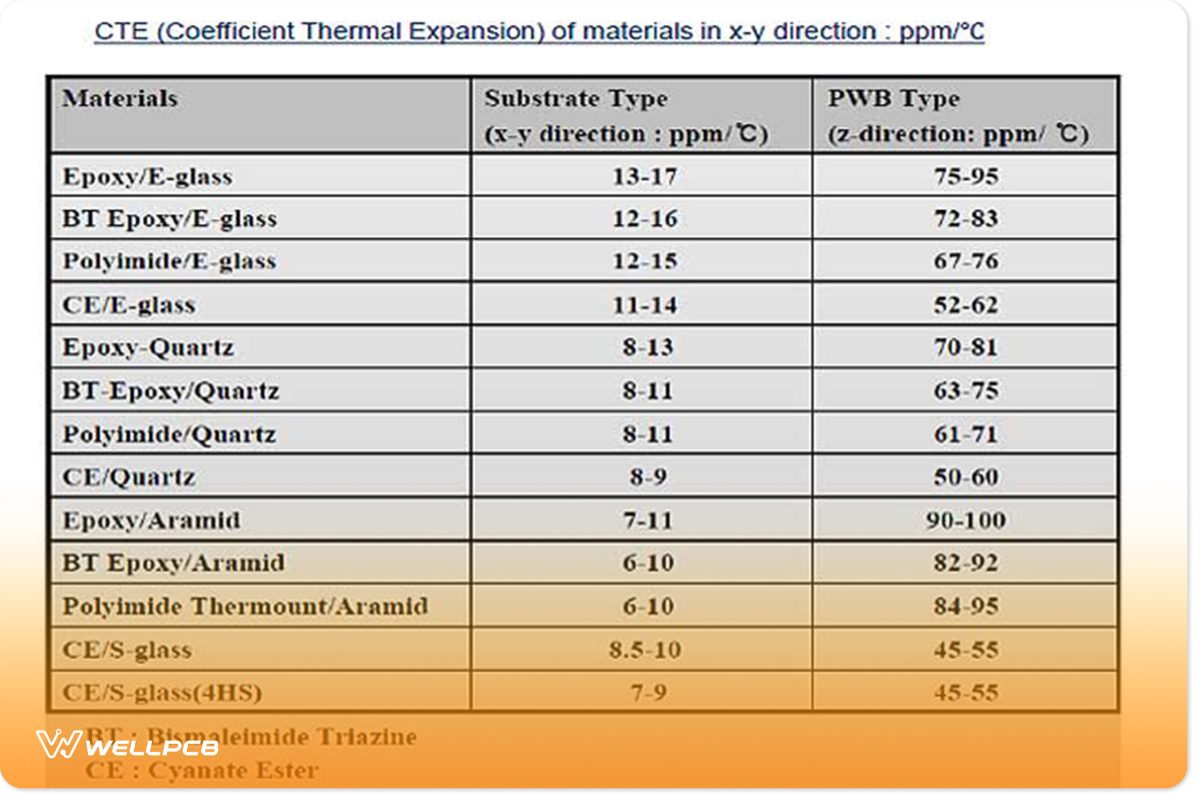
PCB Material Types
There are three basic PCB material types are present:
• The non-woven glass contains a dispersion of glass microfibers in the substrate. They only work at the higher frequencies, but the dispersion factor is not good.
• Woven glass made up of weave glass cloth, but this is not good for use, because it has poor mechanical and thermal stability at the multilayer design.
• Filled has a specific range of dielectric constant. Also, other materials like ceramics are for increasing the scale of the dielectric constant.
Aluminum PCB
The basic construction structure of an IMS PCB includes the IC layer will perform as the conducive link between the IC and heat sink. Unlike FR4. The copper and aluminum foil material is placed at the bottom, then the composite resin material, which is an electrical insulator but thermally conductive, and finally, at the top, the copper foil or laminate, and then pressed under high pressure and temperature.
Common PCB thickness is 1.6mm, 100µm ceramic isolation layers, and 35µm copper foil over the insulation layer. The tracks are made of a copper laminate layer. Components are also placed and soldered on the copper layer side.
The aluminum PCB is further divided into subcategories:
- Flexible aluminum PCB
- Hybrid Copper core PCB, or a mixture of specific metal alloys.
- Multilayer aluminum PCB
- Through Hole aluminum PCB
You can use these different types in different applications.
If you compare aluminum PCB with the other PCB material, it has many benefits, i.e.:
- Aluminium is a low-cost metal and is available
- Its processing cost is also low. The final products are low-priced.
- The Aluminium PCBs are environment-friendly, excellent heat dissipater, more durable and lightweight.
- From a mechanical point of view, they are more rigid and reliable, increasing product life and durability.
- From the electrical point of view, they are excellent in EMC-EMI shielding characteristics.
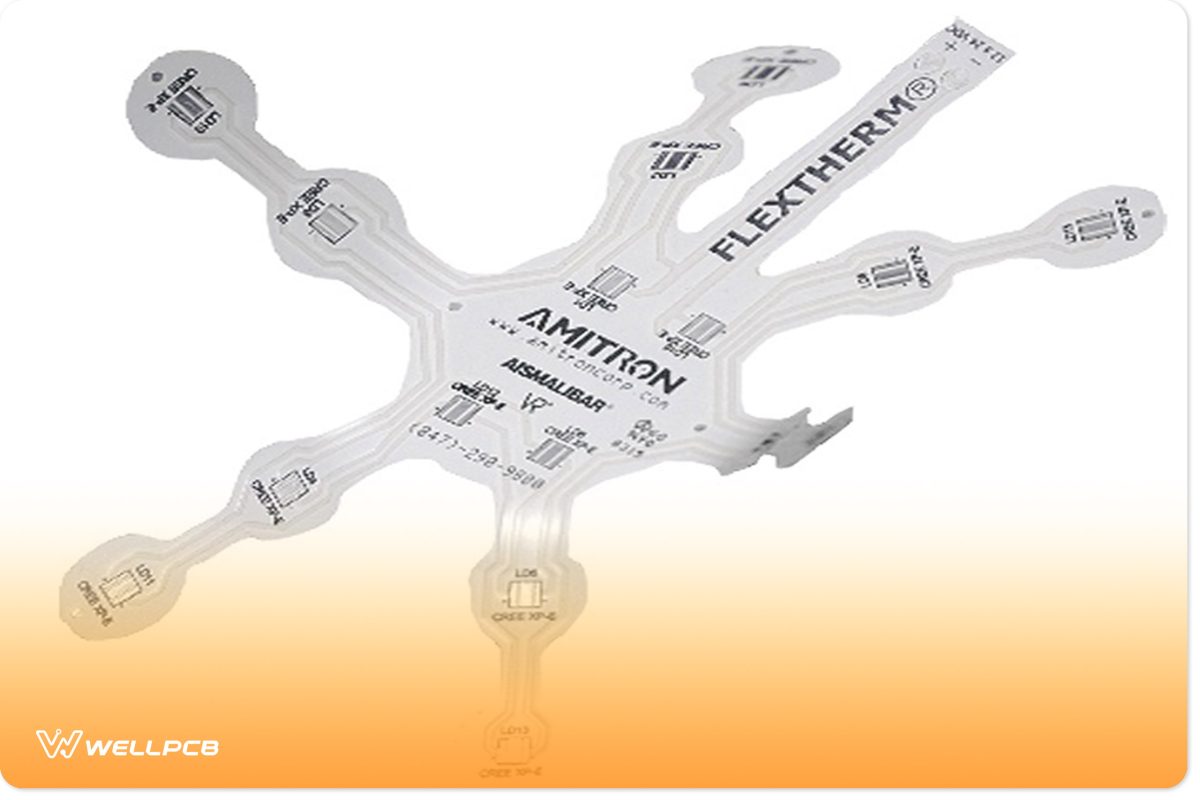
Applications of Aluminum PCB
►These products were developed for high-power switching applications, but they gained enough popularity when they introduced LED applications.
►The aluminum design operates at a higher current for mounted LEDs, keeping the temperature tolerance within specified limits.
►The automotive and RF industries go the extra mile to utilize the advantages of these products and make them available for the common man.
►Aluminium PCBs are a valid choice for applications involving heat dissipation because they provide an ideal exit of the heat with the help of dielectric, maintaining the overall temperature of the project design.
FR4
FR-4 PCB stands for Fire Retardant or Flame Retardant level 4. It is a suitable insulator material, so it does not conduct the current. That is a glass-reinforced epoxy laminate composite material or woven glass with epoxy resin.
A fundamental component of a PCB is an FR-4 PCB panel sheet laminated with a thin layer (such as 17µm, 35µm, or 70µm) of copper on at least one side or both sides.
The FR-4 material, due to its fire-retardant properties, replaced its predecessor, G-10 material, which lacks self-extinguishing properties.
The relative permittivity is 4.4, the dielectric strength is 5MW/m, and the electrical breakdown is 50kV. The glass transition temperature or Tg is another characteristic where the substrate changes its electrical properties abruptly; FR-4 PCB has 140°C Tg.
The Tg varies the substrate from a glassy or resin substrate to a softer and rubbery material.
The FR-4 material provides the base standard for PCB substrates, delivering a widely useful balance between cost, manufacturability, electrical properties, durability, and performance.
As you know, everything has specifications and certain limitations, so FR4 also has certain limitations, which are given below:
►Er (dielectric constant) stability from lot to lot and over frequency is one of them.
►The loss is another, then there is the concern of lead-free processing temperatures, and perhaps thermal conductivity as even low-power RF can consume much power if the active circuits are biased to provide very high linearity.
When ordering an FR-4 PCB or PCB fabrication, the thickness of copper over this material should also be mentioned. High-current circuits need thick, full copper tracks, and the opposite is true for low-current circuits. The default thickness of a PCB material is 1.6mm.
We use FR-4 PCB for low-frequency signals, whereas lower dissipation materials for high-frequency signals such as antenna design, RF and microwave applications.
Other than this, FR4 is commonly used in PCB material because of its efficiency. Some of the other qualities of FR4 are given below:
|
FR4 |
Glass transition temperature | |
|
standard |
130 |
►Most commonly and widely used ►cheapest |
|
Higher glass transition |
130-170 |
►Perfect with the lead-free reflow innovation |
|
Halogen-free |
– |
FR1 And FR2
|
FR1 |
FR2 | |
|
Made up of |
Phenol and paper compound |
Phenol and paper compound |
|
Glass transition temperature | Low temperature, used in single-layer PCB | These materials are halogen-free and non-hydrophobic |
|
These materials are halogen-free, and non-hydrophobic |
These materials are halogen-free and non-hydrophobic |
CEM-1 AND CEM-3:
|
CEM-1 |
CEM-3 | |
|
Material |
paper and two layers of woven glass epoxy and phenol compounds |
white colored, glass epoxy compound |
|
Usage |
Use in single-sided PCB |
Use in double-sided PCB |
|
Price |
Higher price than FR4 |
Lower cost than FR4 |
Polyimide
We often use this material in flexible PCBs. This is made up of keeping on, Rogers, DuPont. This material has excellent electrical properties and a wide temperature range. The working temperature range is 200-300 degrees centigrade.
Prepreg
Prepreg stands for pre-impregnated. It is fiberglass impregnated with resin. These resins are pre-dried so that when you heat, they flow, stick, and are immersed.
Prepreg is a similar adhesive layer to the FR4 which gives the strength. According to the resin content, there are many versions of this material SR- standard resin, MR- medium resin, and HR-high resin.
The version is chosen according to your layer structure, thickness, and quality impedance. This material is also available as halogen-free and high glass transition temperature.
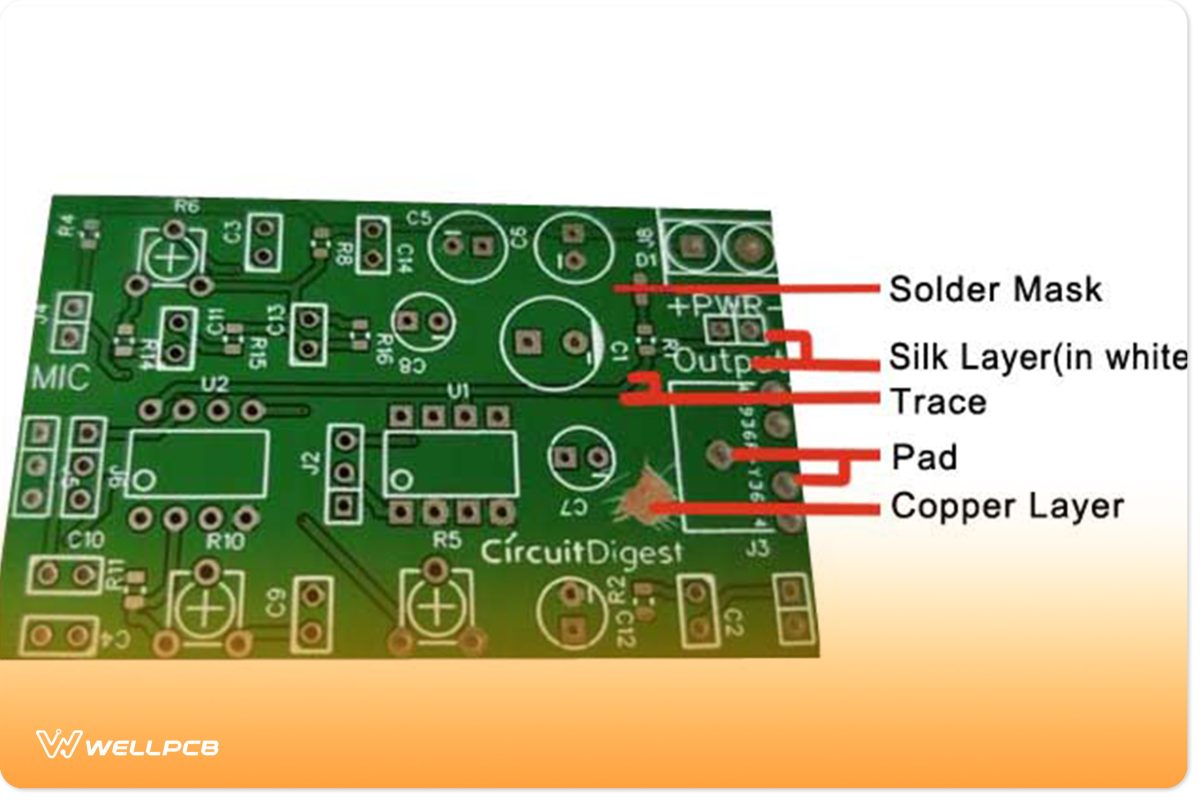
How To Choose PCB Materials For Your Board
Different types of PCB materials are available in the market today. However, finding good quality of these materials could be a challenge especially if you lack sufficient knowledge on the criteria to follow when selecting PCB materials to use. This article will provide you with the information you require to settle for the right PCB materials.
Thermal Properties
· Thermal Conductivity (k)
The ability of PCB materials to conduct heat is referred to as thermal conductivity. A material’s thermal conductivity level determines its ability to transfer heat. The thermal conductivity of a material is measured in Watts per Meter at Kelvin (W/Mk). In most dielectric materials, thermal conductivity is within the range of 0.3 W/Mk to 6W/Mk. Copper has a thermal conductivity of 386 W/Mk. Due to its high thermal conductivity, it can transfer heat at a higher rate than PCB’s dielectric layer.
· Decomposition Temperature (Td)
When a PCB substrate is exposed to temperatures that exceed a given threshold level, it tends to decompose. Decomposition temperature is the range within which decomposition of the substrate occurs. Once decomposition of the substrate has occurred, it cannot be reversed even when it is exposed to low temperatures. It is, therefore, necessary to select a PCB material that can withstand the temperature range in which you work. It is recommendable to choose a material that can withstand temperatures above 250 0 C. To solder the PCB substrate, a temperature range of between 200 degrees Celsius to 250 degrees Celsius is required. The decomposition temperature should be above that range, while the glass transition temperature should be below the range.
· Glass Transition Temperature (Tg)
When a PCB substrate is exposed to high temperatures beyond a given threshold level, it tends to soften. When the substrate is cooled, it gains the initial state it had before heating. Glass transition temperature is the range within which a substrate can be transformed from one form to the other.
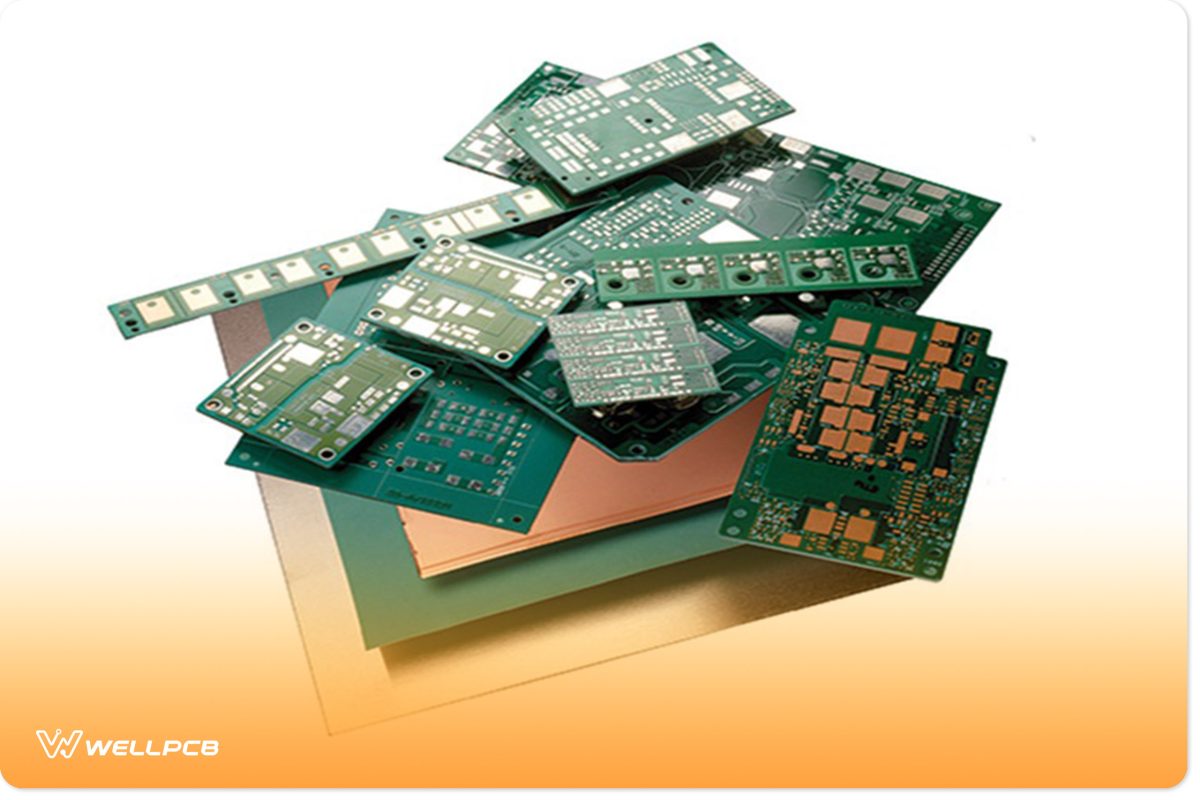
· The Coefficient Of Thermal Expansion (CTE)
The expansion rate of PCBs is referred to as the Coefficient of thermal expansion. It is measured using the units of parts per million (ppm). The coefficient of thermal expansion may increase or decrease depending on temperature variations on the substrate. For example, when the temperatures to which a substrate increases beyond its glass transition temperature, there may be an increase in the material’s coefficient of thermal expansion.
There exists a difference in CTE between the copper layer and the substrate. The copper layer generally has a CTE lower than that of the substrate. When heat is applied, there may be problems of interconnection due to the difference in CTE between the two layers. The CTE of PCB on both the X and Y axis is maintained at a range of between 10 to 20 ppm. The minimum CTE should be maintained. The recommended CTE is about 70 ppm or below.
Electrical Properties to Consider
· Electrical Strength Of A PCB Material
The electrical strength of a PCB is defined as the ability of the material to resist failure or even a breakdown in the electrical system in the Z direction of the PCB. A PCB should have sufficient electrical strength to enable it to resist a breakdown in the electrical system. The unit for measuring electrical strength is Volts/mil. In most cases, PCB materials will have an electrical strength ranging from 800V/mil to 1500V/mil.
· Volume Resistivity
Volume resistance is defined as the ability of the dielectric material to resist electricity or insulation. It is measured in Ohms-meters or ohms-centimeters. PCB materials should have a volume resistivity of between 10 Mega ohms-centimeters. Dielectric materials with high resistivity are preferable as compared to those with lower resistivity. A material’s resistivity can be affected by external factors such as moisture, cold and heat.
· The Surface Resistivity Of A Dielectric Material
Surface resistivity is defined as the ability of the surface of the dielectric material to resist electricity and insulation. The unit used to measure surface resistance is Mega ohms per square. Dielectric materials with high surface resistivity are preferable. A surface resistivity ranging between 10 3 and 10 9 Megaohms per square is preferred for most dielectric materials. Surface resistivity is also affected by external factors such as moisture and high and low temperatures.
· Loss Tangent Or Dissipation Factor.
A dielectric material with a low-loss tangent has fewer power losses. In most PCB materials, the loss tangent ranges between 0.02 and 0.001. Loss tangent increases with an increase in frequency.
· Relative permittivity Or Dielectric Constant
The dielectric constant of a PCB material is significantly affected by signal integrity and impedance. It also depends on frequency. An increase in frequency results in a decrease in the dielectric constant. The usual range of dielectric constant of a PCB material falls within the range of 3.5 to 5.5. A material to be used in applications that utilize high frequencies should have the dielectric constant, which is stable on a wide range of frequencies. That is very important for safety. Dielectric constant varies more in some materials than in others.
Impacts of heat and power on the selection of PCB Materials
Heat and power are major factors that affect the selection of PCB materials. These include;
· Absorption Of Moisture
The ability of a PCB dielectric material to withstand exposure to moisture is referred to as Moisture Absorption. In most cases, PCB dielectric materials will have moisture absorption ranging from 0.01% to 0.20%.
Moisture absorption of a PCB material affects the dielectric’s thermal and electric properties.
· Flammability
According to Standards for Safety of Flammability of Plastic Materials for Parts in Devices and Appliances (UL94), plastic flame retardant features are categorized from high plastic flammability to low plastic flammability. According to UL94, it is a requirement that specimens of PCB materials should not burn with flaming combustion for more than 10 seconds.
· Methylene Chloride Resistance (MCR)
Methylene Chlorine Resistance in PCB materials is also referred to as chemical resistance. MRC is used in measuring the ability of the dielectric material to resist absorbing Methylene Chloride. In most dielectric materials, the Methylene Chloride Resistance ranges between 0.01% to 0.20%.
Mechanical Properties of Flex and Flex-Rigid Boards:
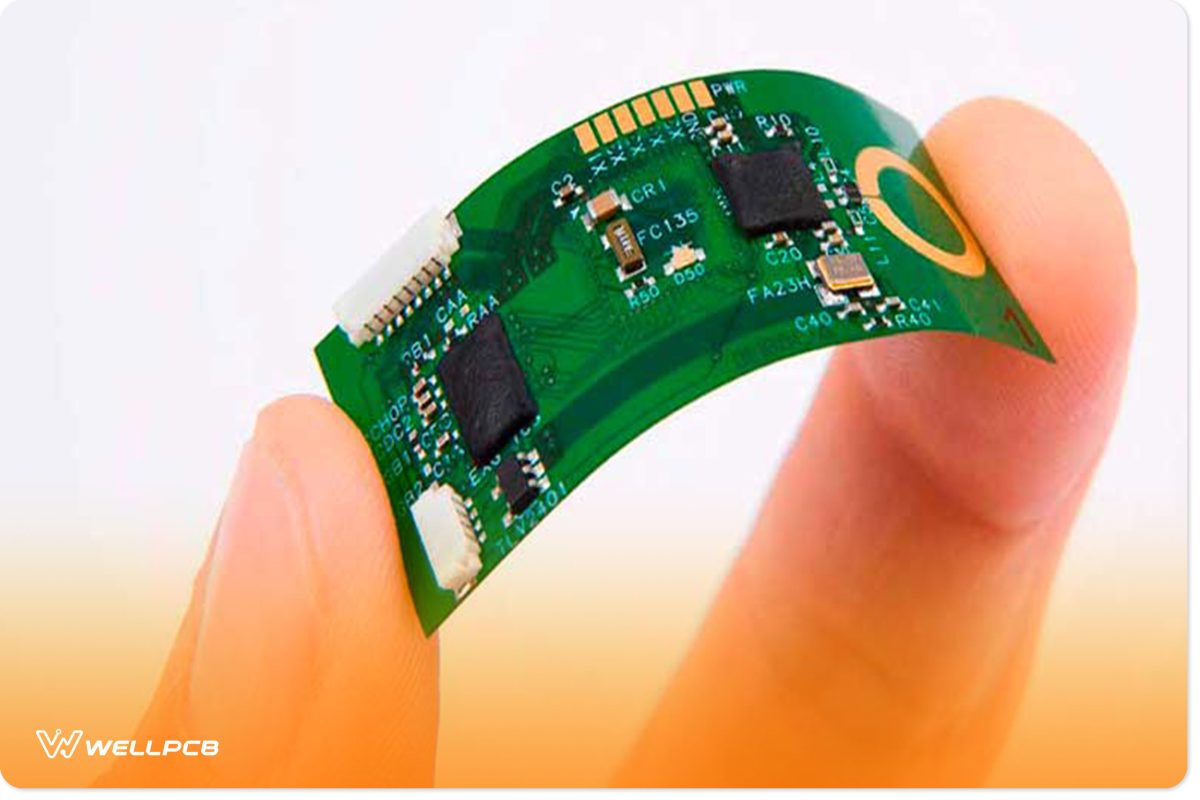
Some of the mechanical properties considered include;
Density
The unit used to measure the density of a dielectric is grams per centimeter cubed. It can also be measured using pounds per cubic inch.
Peel Strength
The peak strength of a PCB material is defined as the ability of copper layers and dielectric material to bond. Manufacturers can test the peel strength of PCB material by exposing copper traces with a thickness of one ounce to high temperatures, chemicals, and heat stress.
Time To Delamination
It refers to the period a dielectric material resists delamination effects. When fiberglass and laminate materials are exposed to moisture or heat stress, they delaminate. The time duration these PCB materials take to separate from each other under moisture or thermal shock conditions is referred to as the time to delamination.
Flexural Strength
The term Flexural strength refers to the tendency of dielectrics not to break when subjected to physical strength. The unit used to measure flexural strength is Pounds per square inch or Kilograms per square meter. There are two ways used to measure the flexural strength of PCBs;
- By exerting force at the center of the board with the ends supported.
- By use of tensile modulus / Young’s modulus.
Other Factors To Consider In Designing PCBs
The Thickness Of Boards Is Another Factor To Consider
Thickness influences the strength of boards. Thicker boards provide greater support when connecting heavy objects to the boards. For plane layers, the standard thickness of copper is 35 microns. Grams and ounces can also be used to indicate Copper thickness. Boards with a copper thickness more significant than the ordinary are better since they support a wide range of applications. In some cases, tracks may transfer power even though they are not meant to. It happens when signals fail to handle frequencies properly, and it may lead to tracks losing high power quantities.
Track Distance
The most appropriate track distance for layer boards consisting of materials with copper track is two inches, and the suitable time for signaling is one nanosecond. It is essential to take into consideration the impacts made by transmission lines on long tracks, especially when the integrity of the signal is important.
The Condition Of The Vias
Most boards have the vias empty such that you can easily see through them. To create a protective barrier against impurities such as dust, the via must be filled. That is done to increase their capacity to conduct current.
Ball Grid Array, abbreviated as BGA, and its pieces are used to fill the vias. When the BGA pin comes into contact with the inner layer, solder is likely to fall and penetrate the other layers through the via. Vias should, therefore, be filled to prevent leakage of solder and to maintain the contact quality.
Cost
High-quality substrates with high frequencies are expensive but durable. It is, therefore, necessary to select a material of high quality, bearing in mind that cheap can also be expensive.
With all the factors mentioned above put into consideration, it is necessary to select materials that are suitable for use with high frequency. The substrate’s dielectric constant should be low, while the foil should have the capacity to maintain low resistance.
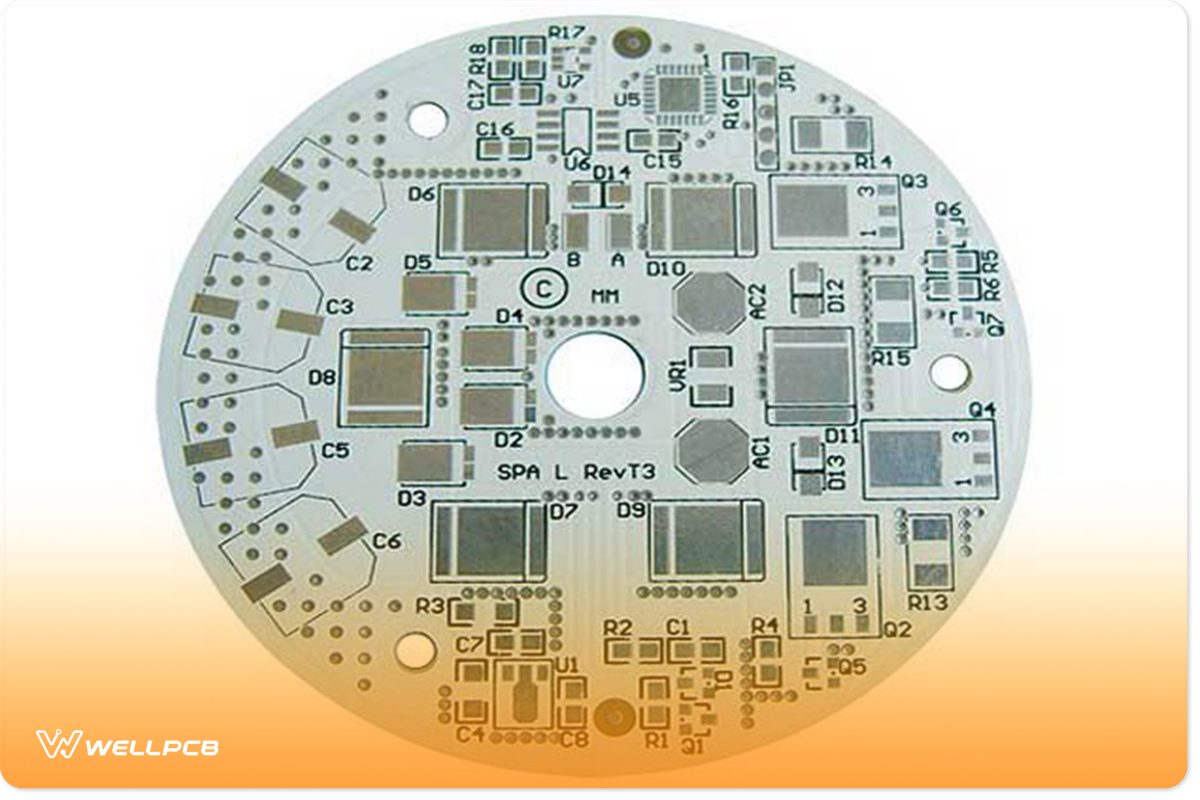
Conclusion
At the end of this discussion, you are now well aware of the PCB requirements and the effects of the environment on this. So from now on, you can select the best PCB material for your project which provides you the best quality results and also long-lasting effects.
WellPCB is the place to get the best PCB manufacturing and assembling services. Our expert team gives your project an ultimate manufacturing experience using FR4, Rogers, and other high-quality materials that are favorite in the industry.
For more information on PCB materials and other topics of interest, you can contact our support team at sales@wellpcb.net.



